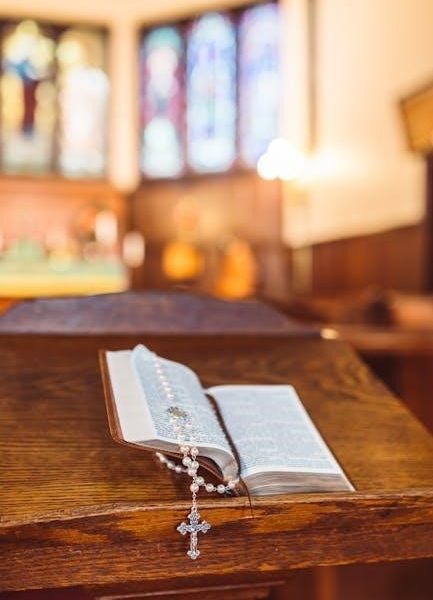Sacrosanctum Concilium, the Constitution on the Sacred Liturgy, is the first major document from Vatican II, signifying its importance. Promulgated on December 4, 1963, it aimed to revitalize the Church through liturgical reform and renewal, marking a pivotal moment.
Significance as First Vatican II Document
As the very first document issued by the Second Vatican Council, Sacrosanctum Concilium holds a place of paramount importance. Its early appearance, after two years of dedicated work, underscores the profound significance the Council Fathers placed on liturgical reform. The document’s position as the initial output of Vatican II highlights the Council’s intention to begin with a revitalization of the Church’s worship life, understanding that the liturgy is the heart of the Church’s existence. This initial focus set the tone for the entire Council, establishing a fundamental principle that the Church’s engagement with the modern world must stem from a renewed understanding of its worship. The choice to begin with the liturgy demonstrates the belief that true renewal must flow from a deeper and more meaningful participation in the sacred rites. It also reflects the conviction that liturgical reform was not merely a matter of changing the rubrics, but a transformative process aimed at drawing believers closer to Christ and fostering a more active role for all the faithful.
Promulgation Date⁚ December 4, 1963
The date of December 4, 1963, marks a significant turning point in the history of the Catholic Church, as it was on this day that Sacrosanctum Concilium, the Constitution on the Sacred Liturgy, was officially promulgated. This event is not merely a historical footnote but a moment that ushered in a new era of liturgical understanding and practice. The promulgation of this document was the culmination of extensive discussions and deliberations amongst the Council Fathers, who recognized the need to bring about a deeper appreciation for the liturgy and its central role in the life of the faithful. The choice of this date emphasizes the importance of the document as the first major output of the Second Vatican Council, representing a commitment to renewing the Church from its core. The 4th of December 1963, therefore, symbolizes the beginning of a journey towards a more participative and meaningful experience of the sacred liturgy for all believers.

Key Themes and Principles
Central to Sacrosanctum Concilium are themes of liturgical reform and Church renewal, emphasizing the liturgy as both the source and summit of Christian life. Hope is infused throughout its directives.
Liturgical Reform and Church Renewal
Sacrosanctum Concilium initiated a profound liturgical reform, aiming for a deeper engagement of the faithful in the sacred rites. This reform was not merely about changing rituals, but about fostering a genuine renewal of the Church’s life, bringing it closer to its divine source. The document sought to move away from a passive observation of the liturgy to active participation, recognizing the liturgy as a vital expression of the Church’s identity. This call for renewal encompassed a desire to make the liturgy more accessible and understandable to all, promoting a stronger connection between the faithful and the mysteries of Christ. The reforms were intended to be both pastoral and theological, aiming to enhance the spiritual experience of every believer. Ultimately, Sacrosanctum Concilium envisioned a liturgy that was both a source of grace and a catalyst for personal and communal transformation, drawing the Church into a more profound relationship with God.
The Liturgy as Source and Summit
Sacrosanctum Concilium emphasizes the dual nature of the liturgy as both the source and summit of the Church’s life and activity. It is a source, being sacramental and providing the grace necessary for Christian life, from which all other ecclesial actions flow. This means that the liturgy is not just a religious practice but is the foundation for the Church’s mission and service to the world. Simultaneously, the liturgy is the summit, the highest point to which all other activities of the Church are ordered. It represents the ultimate expression of the Church’s relationship with God, a privileged encounter with the divine. All the Church’s endeavors, from social justice to education, are directed towards this culmination of grace and communion, making the liturgy not merely a part of the Church’s life but its very heart and soul. This understanding shapes the reforms envisioned by the document.
Hope Infused in Liturgy
Sacrosanctum Concilium underscores that the liturgy is fundamentally infused with hope. This hope is not merely a passive expectation but an active engagement with God’s promises through the liturgical actions. The document highlights how the liturgy, through its various rites and prayers, constantly points towards the ultimate fulfillment of God’s plan. Every celebration is meant to be an experience of encountering the risen Christ, a foretaste of the heavenly banquet, and a source of encouragement for our earthly pilgrimage. The liturgy is presented as a means of personal transformation, where believers are constantly reminded of God’s love and mercy. This perspective ensures that the liturgy is not viewed as a routine but rather as a dynamic and transformative encounter, inspiring hope and encouraging the faithful to live out their baptismal calling with renewed zeal and anticipation of the future glory. The document emphasizes that the liturgy is meant to be a beacon of hope.

Specific Directives and Changes
The document mandated an expanded lectionary, introducing a three-year cycle for Sundays and a two-year cycle for weekdays. These changes aimed to provide richer scriptural engagement for the faithful, enhancing their liturgical experience.
Expanded Lectionary Implementation
A significant change following Sacrosanctum Concilium was the implementation of an expanded lectionary. This reform dramatically increased the amount of scripture read during Mass. Prior to this, the readings were often limited and repetitive. The move was a deliberate attempt to expose the faithful to a broader range of biblical texts, fostering a deeper understanding and appreciation of God’s word. This expansion was not merely about adding more readings, but about creating a more comprehensive and engaging liturgical experience. The new lectionary aimed to present a more complete narrative of salvation history over the course of the liturgical year. This shift was a key element of liturgical renewal, encouraging active participation and spiritual growth among the faithful by offering a richer diet of scripture.
Three-Year Cycle for Sundays
The introduction of a three-year cycle for Sunday readings was a cornerstone of the expanded lectionary. This innovation, directly resulting from Sacrosanctum Concilium’s directives, ensured that the faithful would encounter a wider range of scripture over a triennial period. The cycle, designated as A, B, and C, each highlights a different gospel, allowing for a more comprehensive exploration of the life and teachings of Christ. This rotation prevents the repetition of readings each year and creates a richer liturgical experience. This change was not arbitrary; it was a deliberate attempt to provide a more diverse scriptural diet to the faithful. The three-year cycle allows for a greater focus on different aspects of the Gospels and epistles, fostering deeper theological reflection and understanding among the congregation. This system encourages a more profound engagement with the word of God.
Two-Year Cycle for Weekdays
Complementing the three-year cycle for Sundays, Sacrosanctum Concilium also spurred the implementation of a two-year cycle for weekday readings. This system, designed to offer a greater variety of scriptural texts during the week, is designated as Year I and Year II. This cycle ensures that those attending daily Mass are exposed to a broader selection of biblical passages than was previously the case. By providing different readings each year, the two-year cycle encourages a more comprehensive understanding of the scriptures. The move was intentional, aiming to facilitate spiritual growth through a richer exposure to the word of God, offering a balanced view of the Old and New Testaments. The two-year weekday cycle contributes to a deeper liturgical experience for the faithful, encouraging them to engage with scripture on a daily basis. This promotes a more profound connection to God’s word throughout the week.

Historical Context and Impact
The 60th anniversary of Sacrosanctum Concilium marks its profound influence on post-conciliar liturgy. This document, the first from Vatican II, reshaped the Church’s approach to worship and continues to inspire.
60th Anniversary of Sacrosanctum Concilium
The 60th anniversary of Sacrosanctum Concilium, celebrated on December 4, 2023, provides a significant moment to reflect on its lasting impact. This landmark document, the first constitution of Vatican II, has fundamentally reshaped the liturgical practices of the Catholic Church. Commemorations and studies during this anniversary year highlight the ongoing relevance of its principles. The anniversary serves as an opportunity to deepen understanding of the constitution’s original intent and its continuing call for authentic liturgical renewal. Examining its historical context and implementation allows for a more nuanced appreciation of the changes brought about by the document. This milestone prompts reflection on how the constitution’s vision for active participation and liturgical formation are being realized today. It also invites renewed engagement with the text itself, fostering a deeper connection with the liturgy as a source and summit of Christian life. The anniversary encourages both clergy and laity to recommit to the spirit of Sacrosanctum Concilium.
Influence on Post-Conciliar Liturgy
The influence of Sacrosanctum Concilium on post-conciliar liturgy is profound and far-reaching. The constitution initiated a period of significant liturgical reform, leading to substantial changes in the way Mass is celebrated and sacraments are administered. The expanded lectionary, with its three-year cycle for Sundays and two-year cycle for weekdays, represents a direct implementation of the constitution’s principles. These changes sought to make the liturgy more accessible and engaging for the faithful, encouraging active participation. The reforms emphasized the communal nature of worship, moving away from a more passive experience. The use of vernacular languages in the liturgy, another key change, also aimed to make the prayers and readings more understandable. These liturgical changes continue to shape the liturgical landscape of the Catholic Church, reflecting the constitution’s goal of fostering a more vibrant and meaningful worship experience. Ongoing discussions about its implementation continue.

Sacrosanctum Concilium and the Faithful
Sacrosanctum Concilium seeks to draw believers closer to Christ through the liturgy. It encourages active participation, fostering a deeper understanding and appreciation of the Church’s sacred rites, and beckons all to join Christ.
Drawing Believers to Christ
Sacrosanctum Concilium, as the initial document of Vatican II, is profoundly aimed at drawing believers into a more intimate relationship with Christ through the sacred liturgy. It emphasizes that the liturgy is not merely a set of rituals but a dynamic encounter with the living God, the summit and source of Christian life. By promoting a deeper understanding of the liturgical actions, the Council sought to make the faithful more aware of Christ’s presence in the sacraments and the Word. The reforms encourage active participation, moving away from passive observation, enabling each person to fully engage in the prayer and worship of the Church. This active involvement is seen as a pathway to a more profound personal connection with Christ, transforming the faithful into active participants in salvation history. The document beckons everyone to join Christ in the act, ensuring the liturgy serves its purpose of fostering a closer union with Him.
Encouraging Participation in Liturgy
Sacrosanctum Concilium fundamentally shifts the understanding of the liturgy from a primarily clerical activity to an act in which all the faithful are called to participate fully and consciously. The constitution emphasizes that the liturgy is the work of the whole Church, not just the clergy, and thus, active engagement is not optional but essential. The document’s call for a more accessible liturgy, such as the use of vernacular languages, aimed to break down barriers to participation and allow the faithful to understand and engage more deeply. The expanded lectionary, with its three-year cycle for Sundays and two-year cycle for weekdays, provided a greater exposure to scripture, further encouraging the faithful to engage with the Word of God during worship. This active participation is not merely physical but also spiritual, involving the mind, heart, and soul in the sacred action, fostering a stronger sense of communal prayer and union with Christ.


